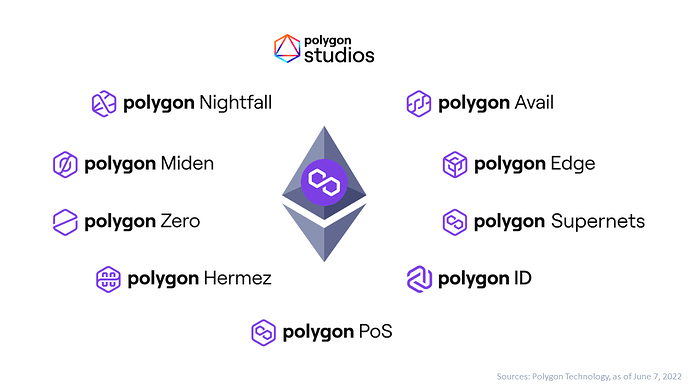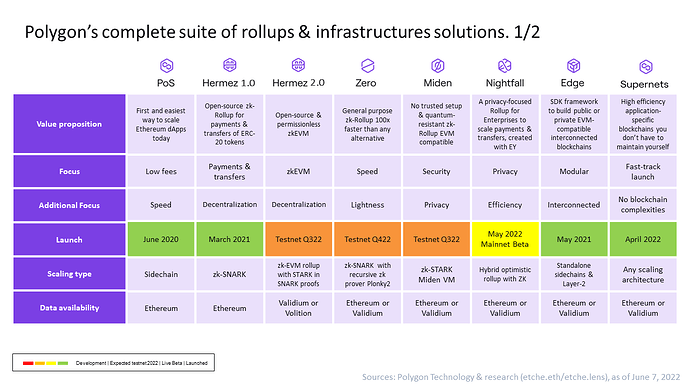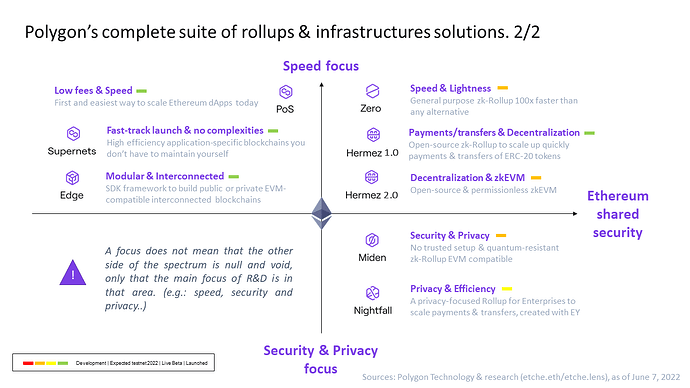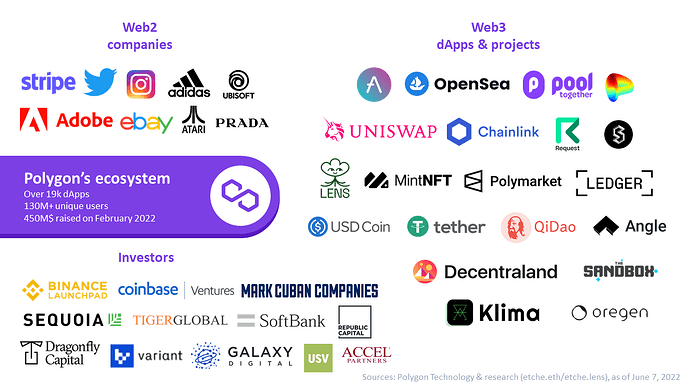Hello,
I published yesterday the article “Polygon & its suite of cutting-edge Ethereum scaling solutions” after joining Polygon Ecosystem DAO to help the Polygon revolution in my humble capacity.
I would love to get feedbacks ![]() (on content and style as I am not a native speaker)
(on content and style as I am not a native speaker)
Thanks a lot!
=> Not all pictures are here on the forum
I) What is Polygon and how does it bring the world to Ethereum?
A) Why do we need Polygon in the first place?
Ethereum, the most secure blockchain in the world, is completely decentralized, with anyone able to run a node, meaning that anyone can participate in the smooth running of the network.
However, this decentralization comes at a cost, the network can only process about 12-25 transactions per second (TPS) making transactions slow and expensive for end users. In comparison, the Visa network operates at about 1700 TPS.
Most of the time, mainstream users are therefore priced out of using directly Ethereum, or don’t want to because of the network speed, victim of its own success. On top of that, these aspects make some use cases economically unviable on Ethereum such as day-to-day finance, supply chain, gaming and much more.
Thanks to scaling solutions such as rollups, sidechains, data availability chains and more, developers are now able to build new kinds of applications.
In this article, I want to introduce you in more depth to the leading platform of Ethereum scaling, Polygon Technology, AKA Ethereum’s Internet of Blockchains or the Amazon Web Services of Web3.
B) Polygon’s mission explained
Polygon’s mission is to scale Ethereum to the next 1 billion users by externalizing the execution layer and in some case the data availability layer, allowing Ethereum to focus on what it does best, providing security on the settlement layer.
Researching Polygon Technology (formerly known as Matic Newtork until February 2021), I discovered that the vision was much more ambitious than what the wider ecosystem thought.
People at Polygon are constantly challenging the status quo by building and shipping new solutions to the world, mostly through a portfolio of Zero-Knowledge (ZK) technologies. (P.S.: no, it’s not tech you build without any knowledge, but we will get to that soon in the next part of this article.)
They understand the multichain world that already exist today and will further develop in the coming years. Most of the web3 users will have a wallet with multiple networks on it and will be switching in and out easily or even automatically based on their needs.
As a result, Polygon is not just one scaling solution for Ethereum but the leading suit of pioneering scaling, infrastructures and privacy solutions such as sidechain (Polygon PoS), zk-ID solutions (Polygon ID), zk-STARK rollup (Polygon Miden), zk-SNARK rollups (Polygon Zero & Polygon Hermez), hybrid Optimistic-zk rollup privacy-optimised for enterprises (Polygon Nightfall), data availability solutions (Polygon Avail) but also modular framework for building private or public Ethereum-compatible blockchain (Polygon Edge) and high performance application-specific blockchain without its inherent complexity (Polygon Supernets).
This wide range of secure, affordable, fast, energy-efficient, and tailored solutions are launched or in development to boost blockchain adoption by making them easy to deploy, accessible for everyone, and interconnected.
In addition, Polygon also manages 1) its own $100m ecosystem fund to find and finance promising projects in the crypto space such as FanTiger (music NFT platform), and 2) its own NFTs and gaming arm called Polygon Studios to foster the growth of NFTs and blockchain gaming on its networks.
Polygon has also implemented its own version of EIP-1559, which means that the burning of its native MATIC tokens has begun.
Polygon’s vision has been financially supported by its community as well as renowned investors and entrepreneurs such as reddit cofounder Alexis Ohanian, Sequoia Capital, SoftBank and Tiger Global.
C) A smart contract with planet earth
They are doing all this with the next generation in mind by paying attention to their climate impact through energy efficient consensus mechanisms and by pledging $20m to a series of community climate initiatives.
Polygon’s emissions for each transaction will be about 0.035g after Ethereum goes proof-of-stake following the merge before the end of 2022. Today, nearly 99% of Polygon emissions come from contracts executed on the Ethereum network. Even so, that’s only about 70 grams of carbon per transaction, which is the equivalent of driving a couple of blocks in an average car.
Ethereum’s transition from proof-of-work (like bitcoin) to proof-of-stake (PoS) promises to dramatically reduce energy consumption and will bring Ethereum’s carbon emissions down to 0.07 kilograms (70 grams) per transaction and thus Polygon’s down to 0.035g per transaction.
II) What are Zero Knowledge (ZK) technologies, rollups and how Polygon is building the ZKVerse with pioneering tech?
Polygon started out with a first scaling solution implemented since 2017 and launched in June 2020, during the DeFi summer, Polygon PoS sidechain, because Ethereum had no scaling solutions available to solve its problems in the short term. However, Polygon’s strategy is now focused on more complex and long term Zero Knowledge technologies, endgame for Ethereum scaling and privacy issues.
A) Zero Knowledge (ZK)
Zero knowledge (ZK) proofs provide a method of proving that you know something, but without requiring you to reveal what you know or even how you know it.
For example, to prove to someone that you know the secret code of a safe without disclosing it or giving them the post it on which you wrote it down, you could just show them a picture of the safe, open.
If we go into a more concrete cryptographic configuration, it means that one person must prove that he knows something (the prover), and another person must verify that it is true (the verifier).
ZK technologies is used by Polygon for privacy and scaling purposes. Mostly, Polygon’s teams use ZK cryptography to create a proof of the execution of transactions on rollups to Ethereum mainnet.
There are 2 types of zk proofs:
SNARK (Succinct Non-interactive ARgument of Knowledge) is a proof system that produces verifiable proofs.
STARK (Scalable Transparent ARgument of Knowledge) is a proof system that enables provers to produce verifiable proofs, without the need for a trusted setup.
B) Rollups
Basically, a rollup is a Layer 2 (layer 1 being Ethereum) scaling solution that executes transactions off-chain, then compresses the data and rolls it up to Ethereum in only one batch to reduce the needed block space and therefore the cost and time to validate a transaction.
In order to prove that the submitted data are valid, there are 2 ways: fraud proofs for Optimistic rollups and validity proofs for ZK rollups.
- Optimistic rollups
The most used fraud proofs solutions are Optimistic rollups that assume every transaction is valid (hence the name!) until someone challenge it by submitting a fraud proof during the 1-week challenge period after submission to Ethereum.
Soundness of this optimistic rollup is based on game theory mechanisms and incentives. Mostly, optimistic are easier to develop and cheaper than other type of rollups.
Polygon’s focus is on the second type, Zero-Knowledge (ZK) rollups, also known as Validity rollups.
- Zero-Knowledge (ZK) rollups aka Validity Rollups
Zero-knowledge (ZK) proof-based rollups are scaling solutions that use mathematics to produce succinct or scalable proofs of transaction validity which then can be verified by anyone off-chain.
Soundness of ZK rollups is mathematically guaranteed and the state transition on L1 Ethereum is instantaneous.
Proofs (SNARKs and STARKS) can be computationally expensive and ZK rollups are harder to program but Polygon’s ZK teams are working on it with already many breakthroughs on speed-of-light recursive proofs, horizontally scaling, zkEVM, STARKS in SNARKS proofs and more.
If you want to know more about rollups and especially ZK rollups, this article is for you.
C) How Polygon is building the ZKVerse
Polygon have published in August 2021 its Zero Knowledge Thesis, allocating $1B of its treasury with the goals of acquiring world class ZK projects and teams, designing and developing ZK based solutions, hiring premium talent, partnering with relevant teams and projects, adoption of ZK solutions, research funding and more.
Since then, the $1B zk-fund have allowed Polygon to acquire/merge the zk-rollup Hermez working on a zkEVM, in a $250 million MATIC tokens deal and the Mir Protocol, renamed Polygon Zero, for $400 million including $100 million in USDC stablecoins and 190 million MATIC tokens.
In addition, Polygon core team have announced the development of Polygon Miden, which is a zk-STARK rollup EVM-compatible, the mainnet beta of Polygon Nightfall, a privacy-focused hybrid optimistic-zk rollup developed with EY and the development of Polygon ID, a web3 identity platform that will offer on-chain verifications and permissionless attestation giving back the users the control of their identity and personal data.
III) Current state of Ethereum’s Internet of Blockchains
A) Analysis of Polygon’s products
- Polygon PoS
Most of the organisations already using Polygon are on its current flagship, the Proof-of-Stake (PoS) sidechain with over 19k dApps as of May 2022, 130M+ unique users and more than 1.7 billion recorded transactions according to Polyscan. In comparison, there are around 2 million apps on Apple Appstore, still so much room to grow for Polygon.
Polygon’s users saved on average $140M on gas each day thanks to the typical transaction fee of around $0,01 on Polygon PoS vs between 5$ and 100$ on Ethereum.
Today, the most ambitious projects choose Polygon solutions to scale up, such as Stripe, Instagram, Lens Protocol, OpenSea, AAVE, the Sandbox and Uniswap V3.
Moreover, Polygon Bridge is the leading bridge by TVL (5 342M$) on Ethereum and the most multi-chains with more than 44 supported networks. (Sources: DeBridges.com)
Polygon’s PoS sidechain differentiators against other sidechains such as POA or go-chain are its permissionless set of PoS validators and its higher TPS.
As for L1s EVM-compatible (Avalanche, Fantom, Celo…) and L1s non-EVM-compatible (Solana, Terra…), Polygon PoS and Polygon rollups stands out due to their ability to achieve scale while maintaining a great degree of decentralization and interoperability, without the need for developers to build from scratch.
The lower transactions cost and lower time to validate a transaction or to withdraw on Ethereum mainnet makes Polygon solutions’ user experience better than layers 2s optimistic rollups such as Optimism or Arbitrum even if Optimism for example is a great L2 project with other strengths bringing a lot to the crypto community notably with innovative governance methods such as the Citizens’ House.
However, as said at the beginning of the article, Polygon is far from being only one solution, let’s discover the others:
- Polygon Hermez
As of today, Polygon Hermez 1.0 is an open-source zk-SNARK rollup optimised for secure, low-cost payments and transfers of ERC-20 tokens.
The 2.0 is expected to go into testnet on Q3 2022 with smart contract support thanks to an innovative decentralized zk-EVM.
Polygon Hermez uses the best of both zero-knowledge proofs. (STARK and SNARK)
First, Hermez uses zk-STARK for proof purposes, which are very fast, but produce heavier proofs.
Then, rather than publishing the heavy zk-STARK proofs as validity proofs, zk-SNARK are published as validation proofs for state changes attesting to the soundness of the zk-STARK proofs and thus reducing the gas cost by 15x.
Jordi Baylina is the lead of Polygon Hermez with about 33 people working with him. He was also tech lead at Iden3, one core component of Polygon ID solution. Hermez development started when he and his team realized that they would need a powerful and decentralized network to support a web3 self-sovereign identity (SSI) solution.
- Polygon Miden
Polygon Miden is a zk-STARK rollup EVM compatible that do not need a trusted setup.
The Miden Virtual Machine (Miden VM) supports arbitrary smart contracts and its zk-STARK proofs according to Polygon “can then be used by anyone to verify that a program was executed correctly, without the need for re-executing the program or even knowing what the program was.”.
Moreover, zk-STARK proofs are quantum-resistant making it a security and privacy focused layer 2. Polygon Miden is expected to go into testnet on Q3 2022.
- Polygon Zero
Polygon Zero is a general purpose zk-SNARK rollup 100x faster than any alternative!
How? Where the majority of rollups group transactions and then generate a proof that each transaction in that group is correct, Polygon Zero uses the recursive zk prover Plonky2 that allow it to scale horizontally by:
Creating very fast proof for every transaction at the same time
Aggregating individual transaction proofs into larger proofs that verify the validity of the individual proofs
Adding a machine (e.g. computer) to the transaction validator network allows for a significant increase in the number of proofs generated and thus increases the number of transactions without increasing the validation time. Polygon Zero is expected to go into testnet on Q4 2022.
- Polygon Nightfall
Polygon Nightfall is a privacy-focused Rollup for Enterprises using both optimistic rollup and Zero-Knowledge (ZK) cryptography to scale payments & transfers on a public network with private transactions.
Nightfall is developed in collaboration with EY to disrupt amongst other things the $50 Trillion global supply chain industry and is in mainnet beta since May 2022.
Many companies from various industries wanted to coordinate their business and logistics needs like traceability and proof of authenticity, secure payments instantaneously, exchange goods and services, reconcile their data and so forth but couldn’t because:
Enterprises could not get such systems in place without blockchain technologies because it would have given too much power to the centralized actor managing this network.
Even with blockchains, companies’ problems were that public blockchains lacked privacy by allowing anyone to see the value and destination of a transaction and that private blockchains lacked credibility and openness to effectively coordinate numerous actors with divergent interests.
Thanks to Nightfall hybrid optimistic-ZK technology, enterprises can now scale their operations in security on a shared-rules public network while conserving the privacy of their transactions.
It’s a bit like tracking your package, but with more automation and a very large network of participating companies.
- Polygon Edge
Launched in May 2021, Polygon Edge is an SDK framework to build public or private EVM-compatible interoperable and interconnected blockchains.
Indeed, Polygon Edge is an amazing service for all companies around the world that will need to have assets in DLT format (Distributed Ledger Technology) to move them easily and securely on Ethereum, Polygon and other EVM-compatible blockchains.
Competitors of Polygon Edge are Cosmos and Polkadot.
- Polygon Supernets
Launched in April 2022, Polygon Supernets are high efficiency application-specific blockchains you don’t have to maintain yourself. They are the fast-track to Polygon Edge’s infrastructure without the inherent complexities of blockchains.
Polygon Supernets “abstract the complexities of blockchain development and simultaneously offer scaling ability and personalization,” Mihailo Bjelic, Polygon co-founder
The dedicated applications on Supernets are also interconnected, can be secured by polygon native token MATIC, managed by certified Edge partners and can use any scaling architecture in function of the application’s needs.
Avalanche has been trying for a long time to create a similar product called Avalanche subnets.
- Polygon Avail
Polygon Avail is a data availability solution that takes transaction data off-chain and allows the zk-rollup to send only a proof of transaction execution to Ethereum, saving block space and money.
The solution is currently under development and is expected to be launched on testnet mid-2022.
Indeed, 80-95% of rollup costs come from publishing transaction data on the Ethereum mainnet.
Avail transforms Rollups into Validiums by externalizing the data availability layer off-chain, only having it publish a small proof of transaction execution on Ethereum while the transaction list is published on Avail, cutting time and cost by about 9x.
This will allow dApps to run on old computers and even smartphones with full security. (like running your own node)
B) Polygon’s Ecosystem is where technology meets community💟
The whole Polygon ecosystem projects are accompanied by a community rarely seen elsewhere with Polygon Advocates, the Ecosystem DAO and its Polygon Village giving builders on Polygon access to welcome vouchers, grants, audit services, infrastructure & API related services, job boards, expert talks etc.
Among +19,000 dApps on May 2022, which is an astonishing 6 fold more vs October 2021, I have my favorites projects: LensFrens (Lens Protocol), Mint NFT, PolyMarket, Request Network, MAI finance (QiDao Protocol), Oregen Earth, and Polygon ID.
- Lens Protocol
I believe Lens protocol is the future of social media and, to some extent, DeFi.
Indeed, as a social graph owned by its users, Lens Protocol allows users to build on-top of it and really own their content in a composable and decentralised way. Then, the Lens ecosystem of dApps can benefits from all the data made available by the whole ecosystem.
The ultimate goal for Lens Protocol is to make their web3 social graph a trust graph empowering their users by providing them with undercollateralized loans using AAVE protocol.
My lensfrens profite: Etche.lens
- Mint NFT
Mint NFT is the world’s simplest NFT creation service on the blockchain that allow to create single or batch NFT mint in an ERC 721 (unique NFT own by a single wallet) or ERC 1155 (multiple copies of NFT that can be owned by multiple wallets).
Moreover, the minted NFT can be transferable or soulbound, meaning that the NFT is bound to your wallet and non-transferable. You can then see your minted NFTs in your wallet or on Opensea and Rarible.
- Polymarket
Polymarket is not just a decentralized betting platform but a place where we can gather information and insights, which also happens to allow people trade on the outcomes of most-highly debated current events.
This creates a collective intelligence on the probability of events occurring and following the odds allows to gather accurate insights about the future.
- Request Network
Request Network is a protocol for payment requests used by more than 1000 enterprises (Arianee, Paraswap, Sandbox), DAOs (MakerDAO, AAVE, Gnosis Safe) and individuals to pay and get paid in cryptocurrencies and tokens such as Ether, Polygon MATIC, ERC20 tokens and more. Each transaction of the Request Network is immutably recorded, and every request is processed without the need for an intermediary.
- MAI Finance - QiDao Protocol
QiDao Protocol with MAI Finance is Polygon’s first native non-custodial stablecoin protocol that allows its users to spend the value of their cryptos while keeping them.
QiDao’s strengths over other stablecoin protocols are related to Polygon’s strengths, speed and cost of transactions are more advantageous to users.
In addition, there is no interest on the loan but only 0.5% interest on the repayment and the protocol accepts a variety of collateral types.
- Oregen Earth
Oregen Earth offers unique collections of NFTs made by independent artists and representing endangered animal species.
Each NFT helps fund the preservation of a species and each resale of the NFT funds a further part of the preservation project.
Moreover, they aim to create a Learn2Earn game in which learning about biodiversity, its erosion, the associated threats, and the means to preserve it will earn $OREGEN, a token planning to become a currency of exchange for all projects on the preservation of life. They will launch their own DEX to facilitate the liquidity of the token, with in addition to the swap function, liquidity pools and farming.
- Polygon ID
Polygon ID is a self-sovereign private by-default identity (SSI) solution that will offer on-chain verifications and permissionless attestation thanks to ZK proofs, putting users in control of their identity and personal data.
Thanks to blockchain technology, verifiable credentials (VCs) and decentralized identifiers, your ID can now be yours, portable rather than app/website specific and living on a public blockchain.
Polygon ID will be composed of 3 parts, 1) Wallet 2) Platform 3) Connect You can choose to prove any part of your identity (age, passions, holdings, name, work experience etc.) without disclosing it, again thanks to ZK cryptography.
Some other projects based on Polygon that I am following: Amasa, Polysynth, OliveDAO, Arc8, Emertech…
C) Which organisations can benefit from Polygon’s solutions?
Many organisations could benefit from using Polygon such as:
-
Games developers such as Voodoo, Sorare or Ubisoft. Why? Today, blockchain-based gaming is a niche in comparison to PC and console gaming due in part to bad UX created by network latency and costly transaction. Game developers can use Polygon solutions to build their games and scale them up without compromising the UX and security.
-
Supply chain operators and global enterprises. Why? At last, enterprises can now scale their operations in security on a shared-rules public network while conserving the privacy of their transactions, without a centralized operator.
-
Finance apps and DeFi protocols. Why? Polygon scaling solutions can help them lower fees, slippage and then encourage more activity on the protocol.
-
Web3 art & music platform such as Audius. Why? Today running on Solana L1 non-EVM compatible, Audius could built on Polygon for more decentralization, security, and interoperability, while keeping transactions fast and accessible.
…and so forth!
For all these organizations, high scalability with added security is a central element, and Polygon has a solution for every need.
The story is just beginning!
*This article is not a recommendation that any particular crypto-currency, token, trade or investment strategy is suitable for any specific individual. You also understand that I am not personally advising you on the nature, potential, value or suitability of any crypto-currency, token, transaction or investment strategy or any other topic. To the extent that any published content can be considered as investment advice or recommendation in relation to a particular asset, such information is impersonal and not tailored to the investment needs of any specific individual.
The article:
The twitter thread:
https://twitter.com/mat_etcheberry/status/1536722814790782977?s=20&t=-73rbD19jGtr-o6xHho1Ng



